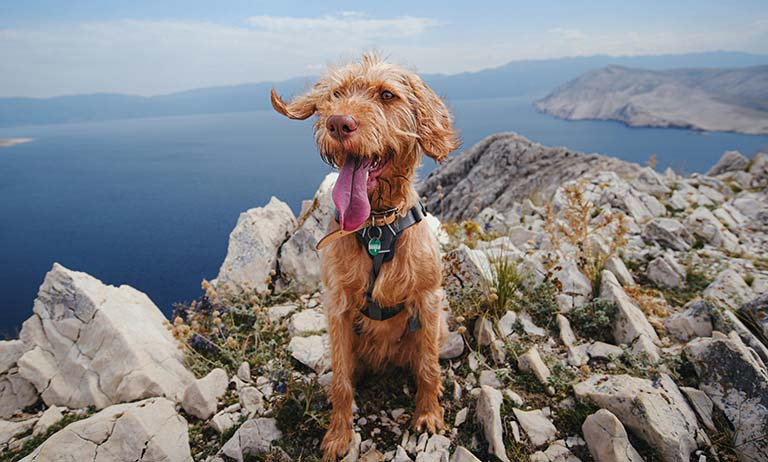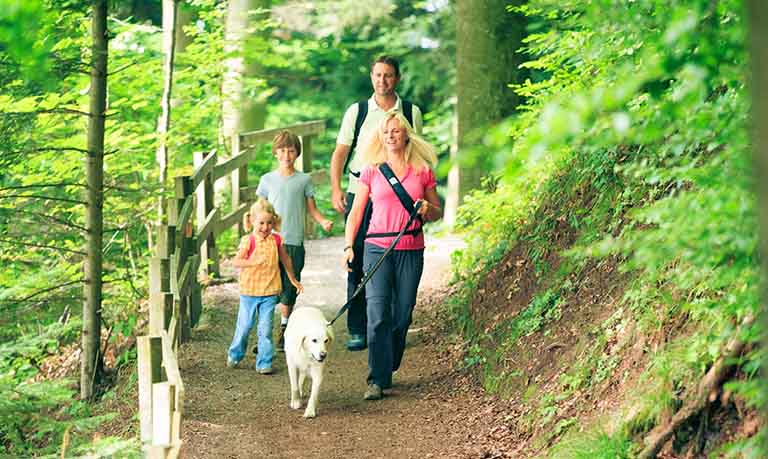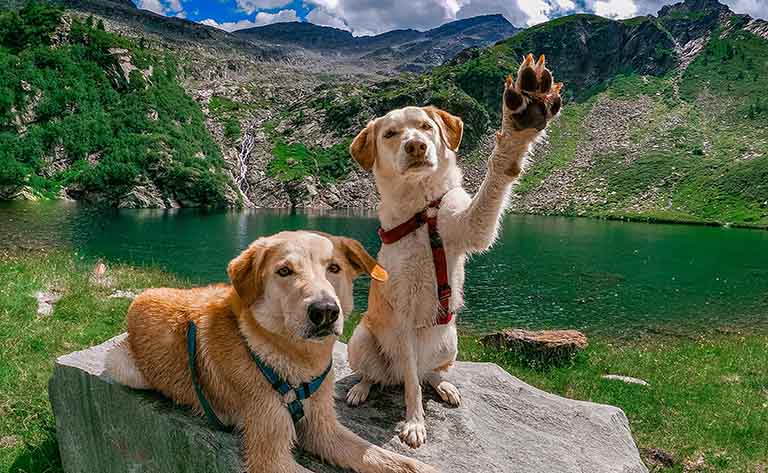Embarking on a national park adventure with your canine companion promises unforgettable experiences amidst nature’s splendor. However, such excursions come with a list of considerations to ensure the safety and well-being of both you and your dog. From packing essentials to navigating wildlife encounters and understanding trail regulations, careful planning is essential for a seamless and enjoyable outing. In this blog, we delve how to plan ahead, the potential risks to watch out and prepare for, the proper training and etiquette to have on the trails and a list of dog-friendly national parks.
Planning Ahead
Packing Essentials
When gearing up for a national park adventure with your furry friend, packing essentials is key for a safe and enjoyable experience. Don’t forget dog food and water, a long leash for control, a pet-specific first aid kit, poop bags, dog food and water bowls, treats, towels for drying off, rain gear and dog booties for paw protection. These items ensure your dog stays nourished, hydrated, safe, and comfortable, ready to embrace the wonders of nature alongside you.

Researching Pet Policies and Regulations
Before hitting the trails in a national park with your dog, it’s crucial to check for any trail restrictions. Many parks have designated pet-friendly trails, while others may prohibit dogs on certain paths, particularly gravel or dirt trails. Paved trails are often more accommodating to canine companions. Familiarize yourself with leash regulations, approved trails, waste disposal guidelines and rules regarding access to bodies of water. By understanding and adhering to these regulations, you can ensure a smooth and enjoyable outing for both you and your furry friend.

Pet-friendly Accommodations
Planning ahead for pet-friendly accommodations is important. Whether you’re camping or seeking lodging nearby, ensuring that your chosen accommodation welcomes pets is essential for a stress-free trip. Many campgrounds and lodges within or near national parks offer pet-friendly options, but availability can vary, especially during peak seasons. It’s wise to book your accommodations well in advance and confirm their pet policies to avoid any last-minute surprises.
Potential Risks
Encountering Wildlife
Crossing paths with wildlife is not just a possibility but a part of the natural experience. While these encounters can be memorable, they also carry potential risks for both dogs and their owners. Wildlife may react defensively or aggressively if they perceive a threat, especially if a dog approaches too closely or acts in a manner that triggers their natural instincts.
Encounters with wildlife can also cause stress and anxiety for dogs, potentially leading to erratic behavior or attempts to chase or confront the wild animals. Understanding how to safely navigate encounters with wildlife, including keeping dogs leashed and under control, maintaining a respectful distance, and being aware of signs of agitation or distress in both wildlife and pets, is essential for ensuring the safety and well-being of everyone involved.

Weather Conditions
High temperatures, especially during summer months, can quickly escalate into a serious threat of heatstroke for dogs, whose ability to regulate body temperature differs from humans. Dehydration is another concern, exacerbated by the exertion of hiking and limited access to water sources along trails. Conversely, chilly temperatures and sudden weather shifts can leave dogs vulnerable to hypothermia, particularly in mountainous regions or during colder seasons.
Additionally, harsh weather conditions like heavy rain or snow can impede visibility and footing, increasing the risk of accidents or getting lost. To ensure the safety and well-being of our furry companions, it’s crucial to be vigilant of weather forecasts, pack appropriate gear such as protective clothing and extra water and adjust your plans accordingly to mitigate these weather-related hazards.

Rough Terrain
The rugged terrain of national parks provides a picturesque backdrop for adventure, but it also poses potential risks for our beloved canine companions. Sharp rocks, jagged terrain and steep inclines can present hazards that may lead to injuries for dogs exploring these environments. Paw pads, which are designed for traversing softer surfaces, can easily become scraped, cut or bruised when navigating rough terrain, causing discomfort and potentially impeding mobility.
Moreover, the uneven footing of rocky trails increases the risk of twists, sprains or even more severe musculoskeletal injuries, particularly on steep inclines or descents where the strain on joints and ligaments is heightened. While dogs are resilient creatures, it’s essential to monitor their movements and behavior closely during hikes through rugged terrain, ensuring they stay safe and minimizing the likelihood of injury by providing supportive footwear, taking regular breaks and avoiding excessively challenging trails beyond their physical capabilities.

Toxic Plants
Dogs possess an innate curiosity that often leads them to explore their surroundings with their noses and mouths, including the vast array of plant life found in national parks. While this curiosity is endearing, it also comes with inherent risks, particularly when it comes to encountering unfamiliar flora that may be toxic to our canine companions. Some plants commonly found in national parks can pose a threat to dogs if ingested, leading to symptoms ranging from mild gastrointestinal upset to severe poisoning. Among the potential culprits are plants such as foxglove, wild mushrooms, poison ivy, poison oak and yew.

Interactions with Other Dogs and People
Interactions with other dogs and unfamiliar people can add an unpredictable element to our adventures in national parks, potentially leading to conflicts or accidents that disrupt the otherwise harmonious atmosphere. While many dogs thrive on social interaction and enjoy meeting new canine friends during their outdoor excursions, not all encounters unfold smoothly. Dogs that are not adequately socialized or accustomed to interacting with unfamiliar animals may exhibit signs of fear, anxiety or aggression when faced with new situations, escalating tensions between themselves and other dogs or their owners.
Training and Etiquette
It’s essential to ensure that your dog behaves in a manner that is respectful to both the environment and fellow visitors. While national parks offer an abundance of sights, sounds and smells that can excite even the most well-behaved dogs, it’s crucial to maintain control and supervision at all times. Keeping your dog on a leash is not only a park regulation in most cases but also a safety measure to prevent them from wandering off, encountering wildlife, or engaging in potentially risky interactions with other animals or people.
Practicing good trail etiquette, such as yielding to hikers without dogs, avoiding disturbing wildlife and picking up after your pet, helps preserve the park’s natural beauty and ensures a positive experience for all visitors. Teaching your dog basic obedience commands like “stay”, “come” and “leave it” can also be invaluable in managing their behavior and keeping them safe during your national park adventures.
To learn tips and tricks for training your dog read here.

Dog-Friendly National Parks
Most national parks in the USA allow pets in developed areas. The list below includes some of the parks that allow pets. To see a comprehensive map of national parks, national monuments historical sites and recreation areas that allow dogs, visit this webpage prepared by the National Park Service.
- Acadia National Park, Maine
- Shenandoah National Park, Virginia
- Indiana Dunes National Park, Indiana
- Sleeping Bear Dunes National Lakeshore, Michigan
- Mammoth Cave National Park, Kentucky
- Arches National Park, Utah
- Zion National Park, Utah
- Olympic National Park, Washington
- Cuyahoga Valley National Park, Ohio
- Bryce Canyon National Park, Utah
- Yosemite National Park, California
- Crater Lake National Park, Oregon
- Joshua Tree National Park, California
- White Sands National Park, New Mexico
- Glacier National Park, Montana
- Grand Canyon National Park, Arizona
- Saguaro National Park, Arizona
- Gateway Arch National Park, Missouri

Be Ready for Adventure
As you prepare to embark on your national park adventure with your dog, remember that safety and preparedness are paramount. By packing essentials, researching pet policies and understanding potential risks, you can navigate the challenges of outdoor exploration with confidence. With careful planning and a deep appreciation for nature’s wonders, you can create cherished memories that will last a lifetime. So leash up, pack your bags and embark on an unforgettable adventure with your canine companion by your side.



